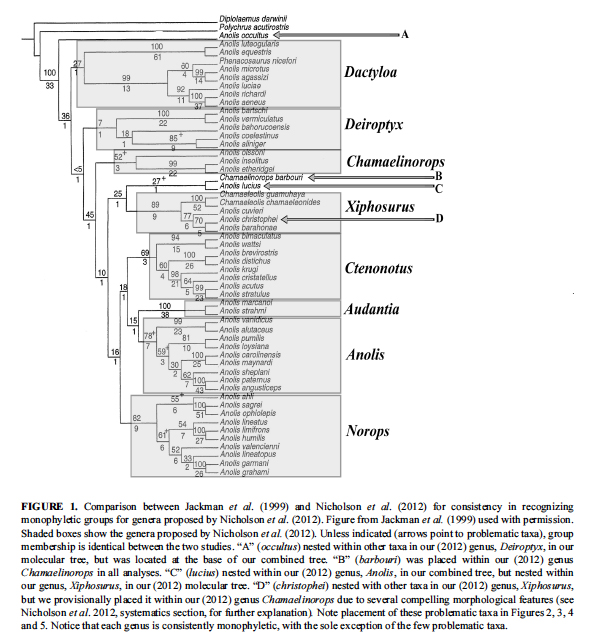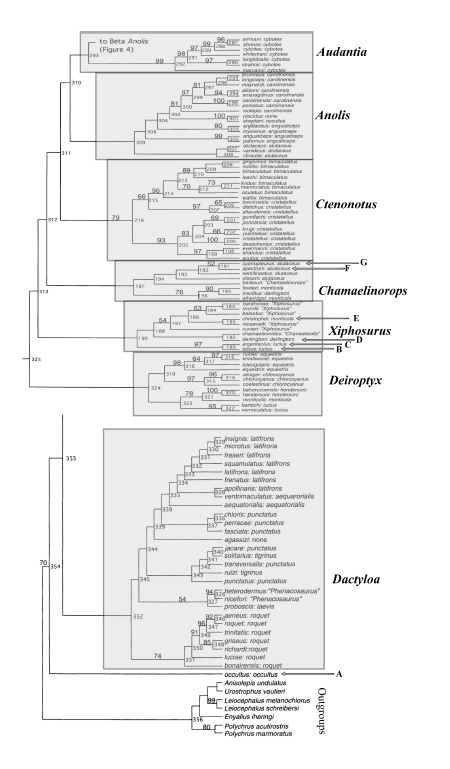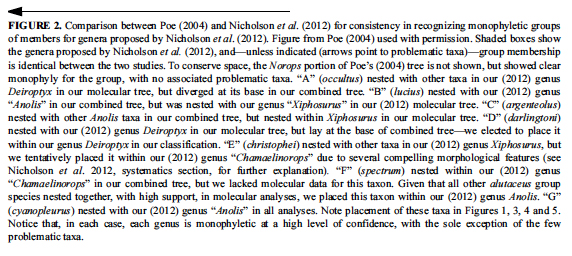| Online: | |
| Visits: | |
| Stories: |
The Battle Over Anole Classification Continues
For those of you who have been living under a rock for the last two years, here’s the short story. In 2012, Nicholson et al. published a monograph in Zootaxa on anole systematics and evolution that proposed dividing Anolis into eight genera. This paper has been much discussed and criticized in these pages (this might be a good place to start). In turn, Poe replied in Zootaxa with a critique widely considered to be overly aggressive in tone. Now, Nicholson et al. have responded to Poe in a nicely written rebuttal that for the most part clearly draws the lines on the areas of disagreement.
This Zootaxa paper is behind a pay-wall, so I thought it might be worthwhile to provide a summary of the main points of the paper in today’s post. In the next two posts, I will discuss what I see as the major issues moving forward.
I’ll summarize Nicholson et al.’s paper following their sections:
Introduction
The authors introduce the paper by citing Poe’s critique and stating: “We acknowledge that science benefits from vigorous, intellectual debate, but would have preferred his commentary to be more constructive, objective, and scientifically accurate. We therefore present this rebuttal to explain how Poe erred in characterizing our work, and missed the opportunity to present an alternative comprehensive taxonomy to replace the one against which he argues so strenuously. In this contribution we explain, and correct, Poe’s errors and misrepresentations, and argue that our taxonomy is likely to be adopted because it 1) eliminates the obvious problem that will arise if the family Dactyloidae contains only a single large genus (i.e., that a single genus obscures the evolution and diversity within the group and misrepresents or cloaks it), 2) conforms with the long historical trend of dissecting large, cumbersome groups into smaller sub-units, 3) is consistent with all recent phylogenetic studies for anoles in membership within clades we recognize as genera, and 4) aids in associating these lizards with the ancient land masses that shaped their history.”
I would only comment on this introduction by saying that criticizing Poe for not providing an alternative taxonomy seems off the mark. Poe made very clear what he thinks the preferred taxonomy is—one in which a single genus Anolis is recognized.
Monophyly and Anole Taxonomy
The paper begins by taking on the criticism that some of their eight genera are not monophyletic. They point out that for any group which has been the subject of multiple studies, there always will be some disagreements about clade membership. They review how they handled these disagreements: “We did not always follow one particular analysis or dataset (i.e., only follow the molecular data or only the Bayesian analysis) because, as systematists, we are all aware that there are always shortcomings in both the data and the analyses, especially when considering large, cumbersome groups. We integrated the available information to make these predictions, and these explanations are included in the systematic section for each group. Morphological and molecular data often disagree, and investigators are left to interpret those results.”
Character Diagnoses for Clades
This section rebuts Poe on a rather technical point about whether it is sufficient to cite diagnostic characters for a clade when those characters are identified from only one of many possible equally likely trees. Although an interesting debate, it is of minor significance compared to the bigger issues under discussion.
Recognition of Monophyletic Groups Across Studies
This is the most important, and most original, part of the paper. The authors state: “Eight major clades are recovered in all studies that have broadly sampled anole taxa (Alföldi et al. 2011; Jackman et al. 1999; Nicholson et al. 2005; Poe 2004), including Pyron et al’s (2013) monumental reassessment of the Squamata. We classified these clades as separate genera because clade membership is so remarkably consistent among analyses, as is membership in 21 of 22 subgroups that we recognized within these genera (Figures 1–5). There are 12 species out of the 240 included in our combined molecular and morphological analysis that are unstable with respect to generic designation in our molecular-only tree, or other recent molecular-only phylogenies.”
Upon further examination of the 12 problematic species, the authors conclude that only “… 5 species that we placed in the genera Anolis (argenteolus, cyanopleurus, lucius, and spectrum) and Chamaelinorops (christophei) …may potentially, eventually, warrant different generic assignments than those we recommended.” Moreover, in a Note Added in Proof at the very end of the paper, the authors state “The recent analysis of several large datasets leads us now to recommend placing the species christophei into our genus Xiphosurus rather than in Chamaelinorops as we suggested in our 2012 paper.” This point refers to the recent papers by Pyron and Burbrink and Gamble et al., recently discussed in our pages (see comments). The authors conclude on this point: “Poe notes that node support for some of the eight major clades of anoles is weak, and concludes that more data are required to justify them. We continue to argue that the consistent recovery of eight dominant clades of anoles in multiple independent studies is sufficient justification for recognizing eight genera. In our view, the pattern is clear; the accumulation of additional data is going to recover these same eight genera.”
The most novel and important part of this paper is the figures 1-5, which show that, for the most part, the same eight clades have been detected time and time again. Here, for example, is the phylogeny from Jackman et al. (1999):
And here’s a comparison to Poe’s own work:
The authors then respond to Poe’s argument that 194 anole species have never been included in any phylogenetic analysis, so how can they be assigned to a clade? They note that most of these species have been put in the Norops and Dactyloa clades and they argue that it is unlikely that those assignments are incorrect.
Nicholson et al. then argue that it is the trend in modern systematics to subdivide large intercontinental genera into smaller clades, and they basically tell Poe and company to get over it. They argue that other proposals, such as using subgenera or the use of Phylocode-style indented and nested lists have not caught on.
The authors then argue, as they have from the outset, that it’s important to divide large genera into smaller units to facilitate the identification of evolutionary patterns, stating “When new monophyletic structure is revealed in groups for which such structure was previously unrecognizable, taxonomy should change to incorporate that new information. This process does reveal constructs inherent to the natural world and, therefore, forces us to change the way we train future generations of biologists, design future comparative analyses, and interpret new data.”
The paper concludes by answering Poe’s question of why eight instead of some other number of monophyletic groupings. The answer to me was surprising because I thought it had already been given above when the authors stated that all previous studies had identified the same eight groups. But instead, the paper concludes this way:
“Our approach was made clear first in Guyer and Savage (1986). Starting with that paper and continuing with every phylogeny of anoles published since, the alpha section of Williams’ (1976) influential taxonomy has been demonstrated to be paraphyletic. In our opinion, responsible taxonomy requires revision of the alpha section into the seven monophyletic groups now known to be needed to replace it. Starting with Savage (1973), we have made clear our conclusion that the beta section of Williams (1976) deserves generic status (Norops); we note that no published phylogeny since then causes us to question that choice. Therefore, the seven additional genera that we propose as replacements for the alpha section represent the minimum number of genera needed to eliminate the problem of the previous taxonomy. This change is a much more important decision than Poe implies. We have noted how misinformative Williams’ (1976) taxonomy has (2012) been to those interested in evolutionary ecology (e.g. van Berkum 1986). We note that at national meetings, and in print, Poe has been remarkably unwilling to relinquish the concept of alpha anoles (see Poe 2004). We suspect his devotion to Williams (1976) prevents him from seeing value in our work in the same way that Williams (1989) was blinded in his criticism of Guyer and Savage (1986; see Guyer and Savage 1992). We are confident that those reading Nicholson et al. carefully will realize that we did consider recognizing additional genera and presented reasons why we did not do so. We expect that future revisions will continue what we have begun and welcome that process because we recognize such revision will further increase the information content of anole classification within the Linnean system. Based on what is happening to other taxa all around anoles, we think it is inevitable that Williams’ (1976a, b) concept of Anolis, as modified and promoted by Losos (2009), will, of necessity, be broken into the smaller units that we proposed (see Vences et al. 2013 for support of this conclusion). We remain confident that, once this bridge has been crossed, those who have been so reluctant to accept this change will wonder why they fought so hard to avoid it. As Greene (2001) notes, “[r]ather than hindering biology, increasingly accurate and phylogenetically based taxonomy promotes the study and appreciation of life’s diversity.” We couldn’t agree more.”
Source: http://www.anoleannals.org/2014/06/08/the-battle-over-anole-classification-continues/







